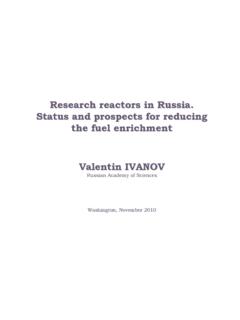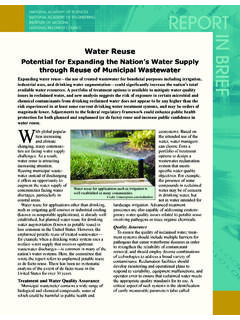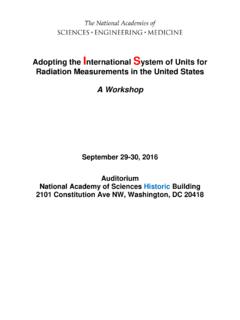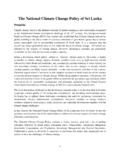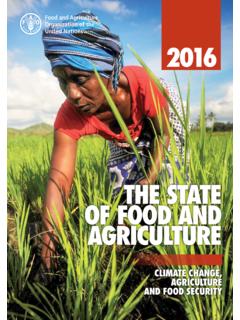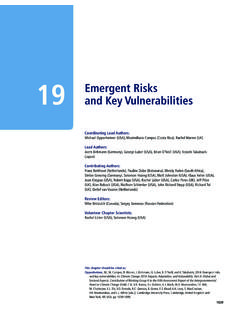Transcription of by degree impacts world - dels.nas.edu
1 Warm ngworldimpacts by degree Based on the National Research Council report, climate Stabilization Targets: Emissions, Concentrations, and impacts over Decades to Millennia (2011)1summary 3main findings 4the human impact on climate 8physical climate changesin the 21st century 16impacts in the next few decades and coming century 26using the science to inform choices 34231 Emissions of carbon dioxide from the burning of fossil fuels have ushered in a new epoch during which human activities will largely determine the evolution of the Earth s climate . 2 Because carbon dioxide is long-lived in the atmosphere, increases in this key gas can effectively lock the Earth and many future generations into a range of impacts , some of which could be severe.
2 3 Therefore, emission reduction choices made today matter in determining impacts that will be experienced not just over the next few decades, but also into the coming centuries and millennia. 4 Policy choices can be informed by recent advances in climate science that show the relationships among increasing carbon dioxide, global warming, related physical changes, and resulting impacts . These impacts include changes in streamflow, wildfires, crop productivity, extreme hot summers, and sea-level rise, along with associated risks and faces important choices in this century regard-ing emissions of heat-trapping (green house) gases and the resulting effects on the Earth s climate , ecosystems, and people. Human activities are responsible for the observed increases in atmospheric concentrations of several impor-tant greenhouse gases.
3 These added gases carbon dioxide in particular very likely account for most of the globally aver-aged warming since 1950. There is now more carbon dioxide in the air than at any time in at least 800,000 years. This amount could double or nearly triple by 2100, greatly amplifying the human impact on is widespread interest in reducing emissions of carbon dioxide and other greenhouse gases to stabilize atmospheric concentrations. One way to gauge the implications of any such approach is to identify particular concentrations or sta-bilization targets and assess the emissions reductions necessary to achieve them, as well as the climate impacts that would booklet summarizes the findings of a report from the National Research Coun-cil, climate Stabilization Targets: Emissions, Concentrations, and impacts over Decades to Millen-nia (2011).
4 The report evaluates the implications of different stabilization targets, with partic-ular emphasis on avoiding serious or irreversible impacts on the Earth s climate . Each stabili-zation target results in a different future climate , with changes that may be difficult or impos-sible to reverse for millennia, such as melting of the Green-land Ice Sheet. Some impacts will take hundreds or even thousands of years to emerge because of inherent lags in the climate system and because of the long atmospheric lifetime of carbon dioxide. This report also evaluates impacts expected to occur in the next few decades to impacts of human activities particularly emissions of carbon dioxide, but also including other greenhouse gas emissions, land use, and population growth are so vast that they will largely control the future of the Earth s climate system.
5 This future could bring a relatively mild change in climate , or it could deliver an extreme change from today s climate to entirely different climate conditions that will last many thousands of years. The eventual course of the climate system over millennia will be determined largely by the actions taken this century by governments, businesses, and individuals around the human contribution to global warming is due to increases in the concentration of greenhouse gases and aerosol particles, which alter the Earth s energy budget. In the special case of the greenhouse gas carbon dioxide, cumulative emissions are also an important metric or measure of the effect of humans on the climate system. The best estimate is that 1,000 gigatonnes of human-emitted carbon emissions leads to about C ( F) increase in global average temperature.
6 Cumulative carbon emissions to date (2010) are about 500 gigatonnes, and the rate of global emissions is increasing. Based on current understanding, this warming is expected to be nearly irreversible for more than 1,000 higher the total or cumu-lative carbon dioxide emitted and the higher the resulting atmospheric concentration, the higher the warming will be for the next thousand years. Higher emissions would lead to more warming over many thou-sands of years, allowing more time for key but slow components of the Earth system to act as amplifiers of climate change. For example, warming of the deep ocean over many centuries will release additional carbon stored in deep-sea sediments, and the Greenland ice sheet could shrink or even disappear if global warm-ing remained in the range of C ( F) for several thousand years, raising global sea level by about meters (13-24 feet).
7 Many aspects of climate are expected to change in a linear fashion as temperatures rise. A growing body of research suggests that many important physical changes and impacts in the climate system during the next few decades to centuries will be proportional to global temper-ature increase. It is now possible to utilize increments of change in globally averaged tempera-ture increases of 1 C, 2 C, 3 C, and so forth as a tool for exam-ining a wide range of climate impacts . In turn, each increase in temperature also can be linked to a carbon dioxide emis-sions stabilization target around which emission policies could be structured. This framework helps decision makers weigh the potential risks of climate change; however, the costs of achieving particular emission reductions are not findings1 Approaches to geoengineer future climate , , to actively remove carbon from the atmosphere or reflect sunlight to space using particulate matter or mirrors are topics of active research.
8 If effective, these may be able to reduce or reverse global warming that would otherwise be effectively irreversible. This study does not evaluate geoengineering options, and statements throughout this report regarding the commitment to climate change over centuries and millennia from near term emissions should be read as assuming no geoengineering. Reforestation or other methods of sequestration of carbon are also not general, each degree C of global temperature increase can be expected to produce: 5-10% changes in precipitation across many regions 3-10% increases in the amount of rain falling during the heaviest precipitation events 5-10% changes in streamflow across many river basins 15% decreases in the annually averaged extent of sea ice across the Arctic Ocean, with 25% decreases in the yearly minimum extent in September 5-15% reductions in the yields of crops as currently grown 200-400% increases in the area burned by wildfire in parts of the western United StatesHowever, many other impacts remain difficult to quantify, in part because they depend on additional factors besides climate change.
9 For exam-ple, changes in the risk of flood damage depend not only on precipitation but also on urban-ization and other changes in land cover. In addition, some phenomena beyond the next few centuries such as the potential large-scale release of methane from deep-sea sediments could act as amplifiers that would greatly increase the size and dura-tion of human impact on recent attention has focused on thresholds or tipping points that might trigger wide-spread change. However, while thresholds could be important for some phenomena, many potentially serious changes in physical climate and related impacts increase gradually, in line with the per- degree (linear) estimates outlined above. While this study did not find evidence for tipping points that could be related explicitly to particular stabilization targets, the possibility of surprises increases the larger the warming uncertainty remains in the relationships among the total amount of carbon diox-ide emitted over time, the portion that accumulates in the atmosphere, and the result-ing climate changes and their impacts .
10 One uncertainty is that, as temperatures warm, the abil-ity of seawater to absorb carbon dioxide is expected to decrease, and the percentage absorbed by land-based ecosystems may also decline. However, these processes will be driven by a number of interacting variables that are not yet well-quantified. Further, the amount of global temperature increase likely to result from a given increase in carbon dioxide ranges from about 30% below the best estimate to 40% above it. Thus, each stabi-lization target encompasses a range of potential temperature change and associated risks that must be taken into account in evaluating stabilization targets. The impacts of human activities particularly emissions of carbon dioxide are so vast that they will largely control the future of Earth s climate impacts Can Be Expected?



